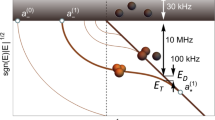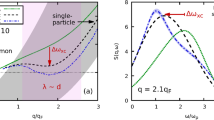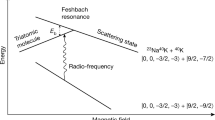Abstract
In 1970, Vitaly Efimov predicted that three quantum particles subjected to a resonant pair-wise interaction can join into an infinite number of loosely bound states, even if each pair of particles cannot bind. The properties of these aggregates, such as the peculiar geometric scaling of their energy spectrum, are universal, that is, independent of the microscopic details of their components. Despite an extensive search in many different physical systems, including atoms, molecules and nuclei, the characteristic spectrum of Efimov trimer states has not been observed so far. Here, we report on the discovery of two bound trimer states of potassium atoms very close to the Efimov scenario, which we reveal by studying three-particle collisions in an ultracold gas. Our observation provides the first evidence of an Efimov spectrum and enables a direct test of its scaling behaviour, providing potentially general insights into the physics of few-body systems.
This is a preview of subscription content, access via your institution
Access options
Subscribe to this journal
Receive 12 print issues and online access
$209.00 per year
only $17.42 per issue
Buy this article
- Purchase on Springer Link
- Instant access to full article PDF
Prices may be subject to local taxes which are calculated during checkout


Similar content being viewed by others
Change history
16 July 2009
In the version of this article originally published online, a correction was needed to Fig. 1a, where E2 should have read E2 . This correction has now been made in all versions of the article.
References
Burnett, K., Julienne, P. S., Lett, P. D., Tiesinga, E. & Williams, C. J. Quantum encounters of the cold kind. Nature 416, 225–232 (2002).
Köhler, T., Goral, K. & Julienne, P. Production of cold molecules via magnetically tunable Feshbach resonances. Rev. Mod. Phys. 78, 1311–1361 (2006).
Jensen, A. S., Riisager, K., Fedorov, D. V. & Garrido, E. Structure and reactions of quantum halos. Rev. Mod. Phys. 76, 215–261 (2004).
Efimov, V. Weakly-bound states of three resonantly-interacting particles. Sov. J. Nucl. Phys. 12, 589–595 (1971).
Efimov, V. Energy levels arising from resonant two-body forces in a three-body system. Phys. Lett. B 33, 563–564 (1970).
Thomas, L. H. The interaction between a neutron and a proton in the structure of H3. Phys. Rev. 47, 903–909 (1935).
Efimov, V. Energy levels of three resonantly interacting particles. Nucl. Phys. A 210, 157–188 (1973).
Brühl, R. et al. Matter wave diffraction from an inclined transmission grating: Searching for the elusive 4He trimer Efimov state. Phys. Rev. Lett. 95, 063002 (2005).
Kraemer, T. et al. Evidence for Efimov quantum states in an ultracold gas of caesium atoms. Nature 440, 315–318 (2006).
Knoop, S. et al. Observation of an Efimov-like resonance in ultracold atom-dimer scattering. Nature Phys. 5, 227–230 (2009).
Tiesinga, E., Verhaar, B. J. & Stoof, H. T. C. Threshold and resonance phenomena in ultracold ground-state collisions. Phys. Rev. A 47, 4114–4122 (1993).
Ottenstein, T. B., Lompe, T., Kohnen, M., Wenz, A. N. & Jochim, S. Collisional stability of a three-component degenerate Fermi gas. Phys. Rev. Lett. 101, 203202 (2008).
Huckans, J. H., Williams, J. R., Hazlett, E. L., Stites, R. W. & O’Hara, K. M. Three-body recombination in a three-state Fermi gas with widely tunable interactions. Phys. Rev. Lett. 102, 165302 (2009).
Barontini, G. et al. Observation of heteronuclear atomic Efimov resonances. Preprint at <http://arxiv.org/abs/0901.4584> (2009).
D’Incao, J. P., Suno, H. & Esry, B. D. Limits on universality in ultracold three boson recombination. Phys. Rev. Lett. 93, 123201 (2004).
Braaten, E. & Hammer, H.-W. Efimov physics in cold atoms. Ann. Phys. 322, 120–163 (2007).
Bedaque, P. F., Braaten, E. & Hammer, H. W. Three body recombination in Bose gases with large scattering length. Phys. Rev. Lett. 85, 908–911 (2000).
Petrov, D. S. Three-boson problem near a narrow Feshbach resonance. Phys. Rev. Lett. 93, 143201 (2004).
Esry, B. D., Greene, C. H. & Burke, J. P. Jr Recombination of three atoms in the ultracold limit. Phys. Rev. Lett. 83, 1751–1754 (1999).
Fedichev, P. O., Reynolds, M. W. & Shlyapnikov, G. V. Three-body recombination of ultracold atoms to a weakly bound s level. Phys. Rev. Lett. 77, 2921–2924 (1996).
Weber, T. et al. Three-body recombination at large scattering lengths in an ultracold atomic gas. Phys. Rev. Lett. 91, 123201 (2004).
Nielsen, E. & Macek, J. H. Low-energy recombination of identical bosons by three-body collisions. Phys. Rev. Lett. 83, 1566–1569 (1999).
Massignan, P. & Stoof, H. Efimov states near a Feshbach resonance. Phys. Rev. A 78, 030701(R) (2008).
D’Incao, J. P., Greene, C. H. & Esry, B. D. The short-range three-body phase and other issues impacting the observation of Efimov physics in ultracold quantum gases. J. Phys. B 4, 044016 (2009).
Hammer, H.-W. & Platter, L. Universal properties of the four-body system with large scattering length. Eur. Phys. J. A 32, 113–120 (2007).
von Stecher, J., D’Incao, J. P. & Greene, C. H. Signatures of universal four-body phenomena and their relation to the Efimov effect. Nature Phys. 5, 417–421 (2009).
Ferlaino, F. et al. Evidence for universal four-body states tied to an Efimov trimer. Phys. Rev. Lett. 102, 140401 (2009).
D’Errico, C. et al. Feshbach resonances in ultracold 39K. New J. Phys. 9, 223 (2007).
Roati, G. et al. 39K Bose–Einstein condensate with tunable interactions. Phys. Rev. Lett. 99, 010403 (2007).
Fattori, M. et al. Magnetic dipolar interaction in a Bose–Einstein condensate atomic interferometer. Phys. Rev. Lett. 101, 190405 (2008).
Schuster, J. et al. Avalanches in a Bose–Einstein condensate. Phys. Rev. Lett. 87, 170404 (2001).
Platter, L., Ji, C. & Phillips, D. R. Range corrections to three-body observables near a Feshbach resonance. Phys. Rev. A 79, 022702 (2009).
Thøgersen, M., Fedorov, D. V. & Jensen, A. S. Universal properties of Efimov physics beyond the scattering length approximation. Phys. Rev. A 78, 020501 (2008).
Hammer, H.-W., Lähde, T. A. & Platter, L. Effective-range corrections to three-body recombination for atoms with large scattering length. Phys. Rev. A 75, 032715 (2007).
Burt, E. A. et al. Coherence, correlations, and collisions: What one learns about Bose–Einstein condensates from their decay. Phys. Rev. Lett. 79, 337–340 (1997).
Greene, C. H., Esry, B. D. & Suno, A. A revised formula for 3-body recombination that cannot exceed the unitarity limit. Nucl. Phys. A 737, 119–124 (2004).
Acknowledgements
We thank P. Massignan and H. Stoof for motivating this work and for discussions. We acknowledge also B. D. Esry, J. P. D’Incao, R. Grimm and co-workers, and A. Simoni for discussions. We are grateful to S. Bartalini and G. Thalhammer for technical help. This work has been supported by CNR within the EUROCORES Programme EuroQUAM of the European Science Foundation, by the European Research Council through the Starting Grant ‘QUPOL’ and by the Italian MIUR (PRIN2006 programme).
Author information
Authors and Affiliations
Corresponding author
Supplementary information
Supplementary Information
Supplementary Information (PDF 353 kb)
Rights and permissions
About this article
Cite this article
Zaccanti, M., Deissler, B., D’Errico, C. et al. Observation of an Efimov spectrum in an atomic system. Nature Phys 5, 586–591 (2009). https://doi.org/10.1038/nphys1334
Received:
Accepted:
Published:
Issue Date:
DOI: https://doi.org/10.1038/nphys1334
This article is cited by
-
Observation of first and second sound in a BKT superfluid
Nature (2021)
-
Sticky collisions of ultracold RbCs molecules
Nature Communications (2019)
-
The mixing-demixing phase diagram of ultracold heteronuclear mixtures in a ring trimer
Scientific Reports (2019)
-
Degenerate Bose gases near a d-wave shape resonance
Nature Physics (2019)
-
Four-Boson Continuous Scale Symmetry Breaking
Few-Body Systems (2019)



